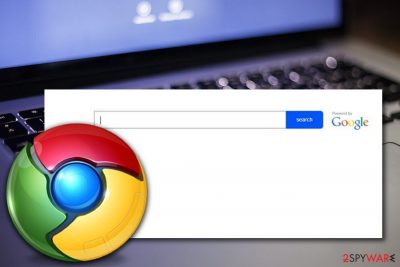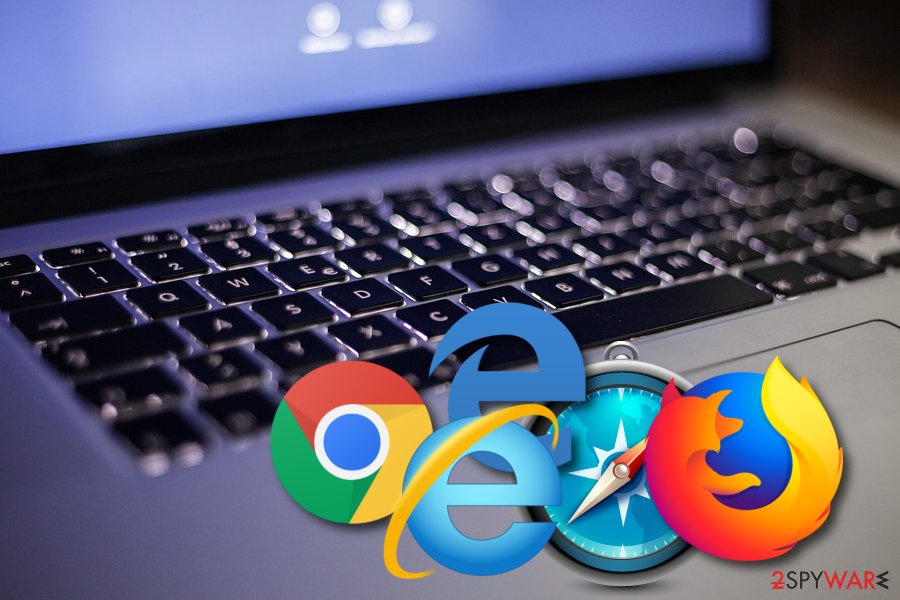Phase Search (Removal Guide) - Tutorial
Phase Search Removal Guide
What is Phase Search?
Phase Search – a browser hijacker that alters the browser's main search provider and might compromise search results

Phase Search is a browser-hijacking product that applies unexpected changes to the main search provider, homepage, and new tab URL zone. When the default search engine is modified, you might start receiving misleading results while completing search queries and cannot trust the information anymore. Additionally, Phase Search virus might insert bogus browser extensions or add-ons to Chrome, Edge, Firefox, or other browser apps. Afterward, you might start receiving annoying advertising content, be forcibly redirected to affiliate domains, and get your browsing history enhanced by the PUP.
| Name | Phase Search |
|---|---|
| Type | Browser hijacker/potentially unwanted program |
| Activities | This bogus app can modify the browser's settings such as the homepage, search engine, new tab URL zone, show intrusive notifications, cause redirects to unknown locations, collect browsing-related data |
| Target(s) | The main targets of this app are browsers such as Google Chrome, Mozilla Firefox, Microsoft Edge, Internet Explorer, and Safari. The app can appear on both macOS and Windows computer systems |
| Danger level | Low. The browser hijacker is not a malicious program such as ransomware or trojans and does not cause severe damage as other cyber threats |
| Elimination | You can get rid of the unwanted app by applying the step-by-step guidelines that are added to the end of this article or by employing reliable antimalware software |
| Repair tip | If you have found out the browser hijacker has compromised some of your system files or entries, you can try repairing those objects by downloading or installing repair software such as FortectIntego |
Phase Search might be capable of multiple activities during one browsing session. For example, the browser hijacker might start delivering advertising content to the user's computer system and providing people with bogus deals and offers. The ads can come in forms of pop-ups, pop-unders, coupons, banners, and in-text ads.
Continuously, Phase Search can also get you involved in redirecting activities that are supposed to take the user to affiliate sources that might be filled with questionable offers of rogue security software. Here you might be convinced to waste your money on useless products and services, so better avoid any types of deals that come provided by PUPs.
Furthermore, Phase Search might start recording your browsing history, habits, and experience by using tracking tools such as HTTP cookies,[1] beacons, and pixels. The developers often seak to figure out what types of offers are relevant at the moment and provide bogus content related to these offers so that income can come from the cost-per-click scheme.[2]

Intrusive advertising and redirecting might visually slow down your web browsers and computer system. Phase Search might start carrying multiple actions at once that can result in frequent computer and app struggles, slowdowns, freezes, and crashes. This can affect your CPU power level also.
For this not to happen, you have to remove Phase Search from your machine and browser apps. You can complete the process by employing automatical software or using manual step-by-step guidelines that have been added to the end of this article. Those steps will also help you to reverse all bogus changes on your browsers.
Continuously, when the Phase Search removal is performed, you should check your system for possibly-altered files and entries. If you discover some compromised components, try recovering them by employing software such as FortectIntego.
Keep in mind that browser hijackers such as Phase Search can come with other PUPs included that can double the negative affect on your web browsers and computer system. Even the least dangerous infections make machines more vulnerable to malware attacks and might increase the chances of a dangerous computer parasite infiltration.
However, removing Phase Search from your computer is not enough. You are safe for now but you have to take specific protection measures to increase your safety in the upcoming future too. For this purpose, check the “Spreading tactics of browser hijackers” part that is written below.

Spreading tactics of browser hijackers
Potentially unwanted programs such as browser hijackers are distributed by using stealth bundling techniques when the PUP comes in an entire software package as an additional product. This often happens if the user has chosen the “Quick/Recommended” mode as the main installation option.
We recommend deselecting this configuration and going for the “Custom/Advanced” option that allows the users to be in full control of their incoming downloads/installations. This way you will be able to deselect all programs that look concerning to you as the “Quick” mode does not provide such a possibility.
Continuously, you should avoid visiting third-party websites such as cnet.com for downloading your software. Get all of your products and services from reliable sources only. Also, it is recommendable to check reviews on the program that you have been looking forward to downloading lately.
Last but not least, installing reliable antimalware protection is also necessary. Get a trustworthy AV product that includes multiple security features (e.g. online browsing, threat prevention, malware detection, system scans, system, and file repairing) and make sure to keep it updated once in a while.
Get rid of Phase Search virus and additional products
Phase Search virus should be eliminated as soon as you see this bogus app on your Windows or Mac computer system. It might be hiding in the Applications folder if it is a macOS that you are running or executing its process in the Task Manager section if you are using a Windows machine.
Remove Phase Search as soon as you see the first infection symptoms on your web browsers that are modified search provider, new tab URL bar, homepage, and injection of suspicious extensions and plug-ins. The manual computer and browser cleaning process has been described at the end of this article.
However, we always recommend trying the automatical Phase Search removal process as this technique is much safer and guarantees a full elimination in a few minutes of time. According to experts from LosVirus.es,[3] it is important to eliminate ALL suspicious components, otherwise, the browser hijacker might be back soon.
You may remove virus damage with a help of FortectIntego. SpyHunter 5Combo Cleaner and Malwarebytes are recommended to detect potentially unwanted programs and viruses with all their files and registry entries that are related to them.
Getting rid of Phase Search. Follow these steps
Uninstall from Windows
To clean your Windows computer system from suspicious applications, try out the following steps
Instructions for Windows 10/8 machines:
- Enter Control Panel into Windows search box and hit Enter or click on the search result.
- Under Programs, select Uninstall a program.

- From the list, find the entry of the suspicious program.
- Right-click on the application and select Uninstall.
- If User Account Control shows up, click Yes.
- Wait till uninstallation process is complete and click OK.

If you are Windows 7/XP user, proceed with the following instructions:
- Click on Windows Start > Control Panel located on the right pane (if you are Windows XP user, click on Add/Remove Programs).
- In Control Panel, select Programs > Uninstall a program.

- Pick the unwanted application by clicking on it once.
- At the top, click Uninstall/Change.
- In the confirmation prompt, pick Yes.
- Click OK once the removal process is finished.
Delete from macOS
Remove items from Applications folder:
- From the menu bar, select Go > Applications.
- In the Applications folder, look for all related entries.
- Click on the app and drag it to Trash (or right-click and pick Move to Trash)

To fully remove an unwanted app, you need to access Application Support, LaunchAgents, and LaunchDaemons folders and delete relevant files:
- Select Go > Go to Folder.
- Enter /Library/Application Support and click Go or press Enter.
- In the Application Support folder, look for any dubious entries and then delete them.
- Now enter /Library/LaunchAgents and /Library/LaunchDaemons folders the same way and terminate all the related .plist files.

Remove from Microsoft Edge
To reverse bogus changes in Microsoft Edge, complete these guiding lines as displayed
Delete unwanted extensions from MS Edge:
- Select Menu (three horizontal dots at the top-right of the browser window) and pick Extensions.
- From the list, pick the extension and click on the Gear icon.
- Click on Uninstall at the bottom.

Clear cookies and other browser data:
- Click on the Menu (three horizontal dots at the top-right of the browser window) and select Privacy & security.
- Under Clear browsing data, pick Choose what to clear.
- Select everything (apart from passwords, although you might want to include Media licenses as well, if applicable) and click on Clear.

Restore new tab and homepage settings:
- Click the menu icon and choose Settings.
- Then find On startup section.
- Click Disable if you found any suspicious domain.
Reset MS Edge if the above steps did not work:
- Press on Ctrl + Shift + Esc to open Task Manager.
- Click on More details arrow at the bottom of the window.
- Select Details tab.
- Now scroll down and locate every entry with Microsoft Edge name in it. Right-click on each of them and select End Task to stop MS Edge from running.

If this solution failed to help you, you need to use an advanced Edge reset method. Note that you need to backup your data before proceeding.
- Find the following folder on your computer: C:\\Users\\%username%\\AppData\\Local\\Packages\\Microsoft.MicrosoftEdge_8wekyb3d8bbwe.
- Press Ctrl + A on your keyboard to select all folders.
- Right-click on them and pick Delete

- Now right-click on the Start button and pick Windows PowerShell (Admin).
- When the new window opens, copy and paste the following command, and then press Enter:
Get-AppXPackage -AllUsers -Name Microsoft.MicrosoftEdge | Foreach {Add-AppxPackage -DisableDevelopmentMode -Register “$($_.InstallLocation)\\AppXManifest.xml” -Verbose

Instructions for Chromium-based Edge
Delete extensions from MS Edge (Chromium):
- Open Edge and click select Settings > Extensions.
- Delete unwanted extensions by clicking Remove.

Clear cache and site data:
- Click on Menu and go to Settings.
- Select Privacy, search and services.
- Under Clear browsing data, pick Choose what to clear.
- Under Time range, pick All time.
- Select Clear now.

Reset Chromium-based MS Edge:
- Click on Menu and select Settings.
- On the left side, pick Reset settings.
- Select Restore settings to their default values.
- Confirm with Reset.

Remove from Mozilla Firefox (FF)
To clean Firefox from unwanted components, use these guidelines below
Remove dangerous extensions:
- Open Mozilla Firefox browser and click on the Menu (three horizontal lines at the top-right of the window).
- Select Add-ons.
- In here, select unwanted plugin and click Remove.

Reset the homepage:
- Click three horizontal lines at the top right corner to open the menu.
- Choose Options.
- Under Home options, enter your preferred site that will open every time you newly open the Mozilla Firefox.
Clear cookies and site data:
- Click Menu and pick Settings.
- Go to Privacy & Security section.
- Scroll down to locate Cookies and Site Data.
- Click on Clear Data…
- Select Cookies and Site Data, as well as Cached Web Content and press Clear.

Reset Mozilla Firefox
If clearing the browser as explained above did not help, reset Mozilla Firefox:
- Open Mozilla Firefox browser and click the Menu.
- Go to Help and then choose Troubleshooting Information.

- Under Give Firefox a tune up section, click on Refresh Firefox…
- Once the pop-up shows up, confirm the action by pressing on Refresh Firefox.

Remove from Google Chrome
To remove suspicious products from Google Chrome, apply the below-provided instructions
Delete malicious extensions from Google Chrome:
- Open Google Chrome, click on the Menu (three vertical dots at the top-right corner) and select More tools > Extensions.
- In the newly opened window, you will see all the installed extensions. Uninstall all the suspicious plugins that might be related to the unwanted program by clicking Remove.

Clear cache and web data from Chrome:
- Click on Menu and pick Settings.
- Under Privacy and security, select Clear browsing data.
- Select Browsing history, Cookies and other site data, as well as Cached images and files.
- Click Clear data.

Change your homepage:
- Click menu and choose Settings.
- Look for a suspicious site in the On startup section.
- Click on Open a specific or set of pages and click on three dots to find the Remove option.
Reset Google Chrome:
If the previous methods did not help you, reset Google Chrome to eliminate all the unwanted components:
- Click on Menu and select Settings.
- In the Settings, scroll down and click Advanced.
- Scroll down and locate Reset and clean up section.
- Now click Restore settings to their original defaults.
- Confirm with Reset settings.

Delete from Safari
Remove unwanted extensions from Safari:
- Click Safari > Preferences…
- In the new window, pick Extensions.
- Select the unwanted extension and select Uninstall.

Clear cookies and other website data from Safari:
- Click Safari > Clear History…
- From the drop-down menu under Clear, pick all history.
- Confirm with Clear History.

Reset Safari if the above-mentioned steps did not help you:
- Click Safari > Preferences…
- Go to Advanced tab.
- Tick the Show Develop menu in menu bar.
- From the menu bar, click Develop, and then select Empty Caches.

After uninstalling this potentially unwanted program (PUP) and fixing each of your web browsers, we recommend you to scan your PC system with a reputable anti-spyware. This will help you to get rid of Phase Search registry traces and will also identify related parasites or possible malware infections on your computer. For that you can use our top-rated malware remover: FortectIntego, SpyHunter 5Combo Cleaner or Malwarebytes.
How to prevent from getting browser hijacker
Protect your privacy – employ a VPN
There are several ways how to make your online time more private – you can access an incognito tab. However, there is no secret that even in this mode, you are tracked for advertising purposes. There is a way to add an extra layer of protection and create a completely anonymous web browsing practice with the help of Private Internet Access VPN. This software reroutes traffic through different servers, thus leaving your IP address and geolocation in disguise. Besides, it is based on a strict no-log policy, meaning that no data will be recorded, leaked, and available for both first and third parties. The combination of a secure web browser and Private Internet Access VPN will let you browse the Internet without a feeling of being spied or targeted by criminals.
No backups? No problem. Use a data recovery tool
If you wonder how data loss can occur, you should not look any further for answers – human errors, malware attacks, hardware failures, power cuts, natural disasters, or even simple negligence. In some cases, lost files are extremely important, and many straight out panic when such an unfortunate course of events happen. Due to this, you should always ensure that you prepare proper data backups on a regular basis.
If you were caught by surprise and did not have any backups to restore your files from, not everything is lost. Data Recovery Pro is one of the leading file recovery solutions you can find on the market – it is likely to restore even lost emails or data located on an external device.
- ^ HTTP cookie. Wikipedia. The free encyclopedia.
- ^ Larry Kim. CPC: What Is Cost Per Click?. Word Stream. Online advertising made easy.
- ^ LosVirus.es. LosVirus. Security and spyware news.























